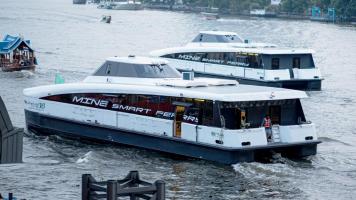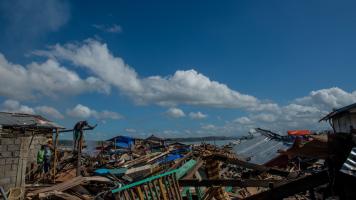Under the Climate Change Action Program, ADB is supporting the Philippines to enhance the enabling framework for mobilizing public and private climate finance in its priority sectors. Photo credit: ADB.
ASEAN member states are managing fiscal risks posed by climate change and unlocking capital for economy-wide decarbonization and climate resilience.
The Association of Southeast Asian Nations (ASEAN) is poised to become the world’s fourth largest economy by 2030, but the region’s future prosperity is jeopardized by growing exposure to climate risks. A study by the Asian Development Bank (ADB) highlights the profound implications of climate change, which could potentially wipe out 30% of Southeast Asia’s annual gross domestic product by 2100 under a high-emission scenario.
As custodians of public finances, finance ministries hold a pivotal role in addressing climate-related fiscal risks and mobilizing climate finance. ASEAN finance ministries are increasingly leveraging their influence to drive climate action by steering fiscal policies and financial instruments toward Paris Agreement goals. On the sidelines of COP29, ADB launched a new report that highlights how countries in Southeast Asia are adopting fiscal risk assessments, integrating fiscal risk management, and mobilizing resources for climate investments. At this side event, ADB—in collaboration with the Coalition of Finance Ministers for Climate Action and the Government of Malaysia—discussed the urgency to transform fiscal and financial systems to align financial flows with low-emission and climate-resilient development. ADB also unveiled its Fiscal Resilience Initiative, which aims to support developing member countries in advancing climate action and strengthening their fiscal sustainability.
Here are 12 ways ASEAN member states are managing the fiscal risks posed by climate change and unlocking capital for economy-wide decarbonization and climate resilience.
1. When disasters triggered by climate change strike, well-coordinated fiscal risk assessments are needed to understand the implications on fiscal health and inform recovery strategies. Following severe flooding in 2018, Lao PDR and its development partners conducted a detailed post-disaster needs analysis to determine economic impacts and deliver targeted interventions for pivotal recovery areas.
2. Integrating climate change into budgeting processes is key to mobilizing domestic financing for nationally determined contributions and national adaptation plans. Cambodia and the Philippines have adopted climate expenditure tracking systems, which facilitate clear monitoring of domestic budgets for climate change priorities and highlight financing gaps.
3. National financing vehicles help mobilize domestic private finance. Indonesia, with ADB’s support, has developed Southeast Asia’ first green finance facility: Sustainable Development Goals (SDGs) Indonesia One catalyzes public and private investment in large-scale sustainable infrastructure projects aligned with Indonesia’s Paris Agreement and SDG commitments.
4. The Philippines has established a national adaptation fund—the People’s Survival Fund— which finances local government and community-driven climate adaptation projects based on three criteria: local poverty incidence, exposure to climate-related risk, and the existence of crucial biodiversity areas. Under the Philippines Climate Change Action Program, ADB continues to support the Philippines in strengthening the fund and other critical climate finance instruments.
5. As an initial step in building a scalable carbon trading platform, Malaysia launched the Bursa Carbon Exchange, the world’s first Shariah-compliant carbon exchange, in 2022. The exchange allows carbon emitters to offset their carbon footprint through the purchase of carbon credits from emissions reduction projects.
6. Implemented in 2019, Singapore’s carbon tax—covering 80% of its emissions—is the first carbon pricing scheme in Southeast Asia and the cornerstone of the country’s transition to a green economy. Singapore plans to use carbon tax revenue to support its green transition while cushioning the impact on businesses and households as the country accelerates its decarbonization efforts.
7. The ASEAN Taxonomy for Sustainable Finance, an initiative by ASEAN finance ministers and central bank governors, provides the overarching framework guiding capital toward sustainable and low-carbon activities across the region through a defined set of criteria. ADB technical assistance supported the revision of the Taxonomy, which is being progressively refined to ensure its rigor and practicality to guide investment in adaptation and mitigation.
8. Thematic bonds have become an important instrument for Thailand to accelerate sustainable finance flows from the private and public sectors. With support from ADB, Thailand issued a THB 30 billion sustainability bond in 2020—the first of its kind by an ASEAN member government—to finance green infrastructure and social impact projects. ADB has played a key role in assisting Thailand with developing innovative finance tools and mobilizing funds from capital markets for climate-smart infrastructure and social development.
9. In 2019, ADB and ASEAN governments launched the ASEAN Catalytic Green Finance Facility (ACGF) to accelerate green infrastructure investments in Southeast Asia by providing technical assistance and access to $1.9 billion in funding from ACGF co-financing partners. In 2023, ACGF supported 16 projects across eight sectors and five ASEAN countries.
10. To help drive decarbonization in the region, ADB, the Global Energy Alliance for People and Planet, and the Monetary Authority of Singapore have established a blended finance partnership designed to mobilize concessional capital from private and public sources for energy transition projects.
11. To abate its reliance on fossil fuels, Indonesia has partnered with ADB to pilot the Energy Transition Mechanism (ETM), a market-based approach to decommission or repurpose coal-fired power plants and replace them with clean energy. ADB is working with Cirebon Electric Power for the early retirement of its 660-megawatt coal power plant with strong just transition considerations.
12. ADB has launched the ASEAN Climate Finance Policy Platform to support finance ministry leaders in mobilizing climate finance and transforming fiscal systems toward climate resilience. The new platform will enhance collaboration and exchange across finance ministries, and support countries in sharing experience, building capacity, and strengthening evidence-based policies.


